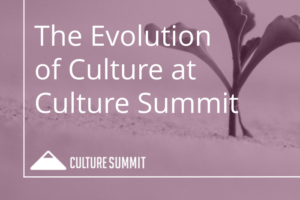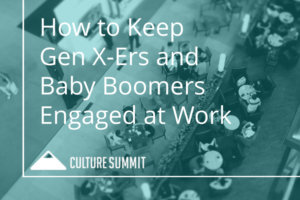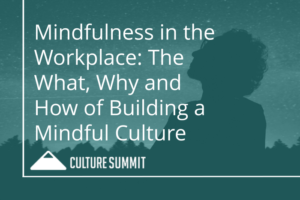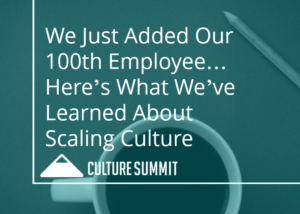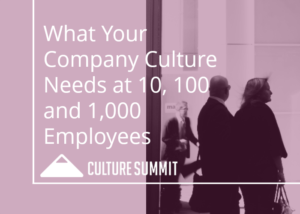As a company grows, something that can make or break it is its culture. A good culture creates happy, hard-working employees who stick around for the long haul. Conversely, a poor culture leads to disengaged employees, poor productivity, and high staff turnover.
Which of these scenarios do you think is going to help a company be more successful?
Needless to say, if your employees are happy, everyone’s happy. But what does it take to create an environment that your employees want to be in, and can thrive in? And how will this change as your company grows?
Some companies think that if they offer a few fun perks, their staff will be happy and the culture will take care of itself – but they couldn’t be more wrong.
While we’re going to discuss perks that can help foster a great company culture, there is so much more to company culture than free beers and flex time.
“Company culture is not a foosball table.” Melissa Tsang, Referral Candy
- Your core values.
- The mindset of your team.
- The environment or “feeling” in the workplace.
These are the things that define your company culture. The perks just help to shape it.
“[Culture] lives in the collective hearts and habits of people and their shared perception of “how things are done around here.”” Bryan Walker and Sarah A. Soule, writing for Harvard Business Review
The ideal company culture is built on people who are there to do more than collect a paycheck – they’re there because they love their work and the people they work with. They’re along for the ride, basically.
Of course, company cultures like this don’t create themselves. It takes hard work, consistency, and an open mind to cultivate a great company culture – and it only gets more difficult as your company grows.
Here are a few key things that every company culture needs at its critical stages of growth, and how your approach to managing company culture needs to change with them.
Company Culture at 10 Employees
Startups have it pretty easy as far as company culture goes since it’s much easier to keep 10 staff members happy than 100. It’s also a good time to experiment and figure out the company/culture fit – after all, if you’re going to get it wrong, it’s better to get it wrong now. That’s because the bigger your company is, the longer it takes to implement cultural change – reportedly about three years, for medium and large organizations.
A solid hiring process
Your employees are the foundation of your company culture, so it’s critical to lay down a process for finding and hiring the right people as soon as possible.
You want to hire (and keep) the people that want to be there. Take Zappos. They offer new hires $2000 – to quit. This is because they only want to keep people that want to be there. If you’re only there for your paycheck, you can take your cash and leave.

Zappos Cubicles
While you don’t need to go that far, you should at least be asking interview questions that are designed to determine whether someone’s a fit for your company culture.
Things like:
- What is (or was) your relationship like with your current (or previous) colleagues?
- What sort of management style do you work best with? (Ask this question when hiring for both management and more junior roles).
- What’s your biggest pet peeve in the workplace?
- What things are most important to you in your professional life?
An open door policy
Your relationship with your employees is as important as their relationship with each other. Prioritize getting to know them. Ensure they always feel comfortable coming to talk to you.
An open door policy should mean literally that – an open door. Sure, there are times you need to keep it closed, but make sure that only happens when absolutely necessary.
Let your employees know that if the door’s open, they’re welcome to come in. If it’s shut, they can send you a message, or come back later.
Of course, simply telling employees they’re welcome to talk to you doesn’t mean they’ll want to. You have to be the kind of manager your staff wants to approach.
This means you…
- Don’t criticize staff when things aren’t going according to plan, and certainly never patronize them. Support them in making improvements, instead.
- Work as hard, or harder, than they do.
- Never, ever, appear put off when staff asks questions or for help. You only have to do this a couple of times before employees start to learn (consciously or unconsciously) that they have to be wary about when, how, and how often they approach you.
- Be transparent – it has a direct correlation to employee morale.
Bear in mind that as your company grows, it’s critical that all new management adopt an open door policy, too.
Keeping leaders close to the rest of the team has been a priority for Power Digital Marketing, which holds monthly, personal one-on-one meetings between execs and juniors – the reason being that (in the words of their CEO Grayson Lafrenz) it “ensures everyone feels like a priority and that their voice is heard. It also deepens the bonds and relationships between our team members.”
A break area
Break areas should offer a comfortable place for downtime where employees can socialize away from their workload.
Prioritize comfortable seating, arranged to encourage conversation, as well as a dining area. Offering entertainment is nice, but not necessary – at least at this stage. As your company grows, the break area and the facilities it offers will have to grow with it.
A regular schedule of social events
Aim for one a month. It doesn’t have to be anything “big” – drinks in a local bar should make most people happy. Don’t feel you have to fund events, either (although a goodwill gesture, like getting the first round, will definitely be appreciated).
Trust in your employees
If anything, this last point is the most crucial.
This is because one of the worst things you can do for any company culture is to micro-manage your employees. Happy employees are born out of a management team that is there for them when they’re needed, but that ultimately trusts them to do the right thing.
“Do not keep smart people on a tight leash.” Barry Appelman
Company Culture at 100 Employees
As your company grows, relationships will naturally change.
10 or so employees are likely to form one, single, tightly-knit group. You’re probably also going to have a very flat management structure.
As more people join the ranks, different “tribes” are going to develop – regardless of how adept you are at bringing the right personalities on board – and there’s a greater chance that some people will feel like they just don’t “fit in.”
In fact, research has shown that the faster your company grows, the more apparent these shifts will be.

Image Credit
It’s certainly not impossible to maintain a close company culture as you grow, though. When MyCorporation started out, they felt like family, a feeling they worried they would lose as they expanded. However, through regular team activities and a culture of kindness and encouragement, they’ve stayed “close and connected.”
That flat management structure which was so fundamental to your company culture in the beginning is likely to change, too. That’s normal, and in most cases, necessary. What you need to do, however, is implement systems that ensure all voices are heard and that everyone, regardless of their role or relationships with others, feels that they’re working towards the same common goal.
A mission statement
While you can write a mission statement at any point, it often makes sense to hold off until the company reaches a certain size and you have a concrete idea of both your company’s and employees’ values.
It’s always a good idea to involve your staff in creating your mission statement, too. Ask them to share what they see as the company’s mission or values, look for common themes in their responses, and work this into a statement that everyone agrees reflects why they come to work and what they’re trying to achieve.
Here’s an example of this in practice from when Buffer set out to define their company values. This is the form they distributed to staff:

And here’s one of the completed forms they got back:

Regular culture reviews
Ask employees to rate your culture on a scale of 1-10 and provide feedback on what they do and don’t like about it.
Do this once a year, unless responses signal that more regular reviews are needed.
Input from employees
Allow your staff to get involved in shaping company culture. Encourage feedback and make speaking up easy by implementing a system in which employees can share thoughts and ideas anonymously, or at least without judgment.
An onboarding process
The bigger the company, the more difficult it generally is for new employees to fit in. This means that implementing (and following) a set of procedures for onboarding new employees is essential.
This should include things like:
- Ensuring someone is in the office and ready to greet the new hire as they arrive.
- Getting everything they need to work (computer and phone, for example) set up and ready to go before they arrive.
- Giving them a tour of the premises and introducing them to everyone they’ll be working with.
It’s also a great idea to assign each newbie a “buddy” who will take them under their wing, show them the ropes, and be their first port-of-call for answering questions.
An ability to adapt to changing staff dynamics
The sort of relationships a company of 10 might have are often impossible or inappropriate to maintain in a company of 100 or more. Learn how relationships change as companies grow, and figure out how you can help your staff foster and maintain strong relationships – with both existing and new staff members – as the number of faces they see every day increases.
Company Culture at 1000 Employees
A company with 1000 employees probably has multiple sites in different cities. They may well have even expanded into other countries. One of the biggest challenges, therefore, becomes maintaining, across all branches, a culture that’s in line with the company’s core values, but that also accommodates the unique needs of each location and its people.
The delicatessen chain Zingerman’s is one such company that has dealt with the issue of maintaining their culture across different locations. Their solution was to push for a coherent culture across all locations, but to allow for cultural variations across different departments and shifts. Specifically, they encourage their leaders “not to fight against this diversity, but rather to focus on the positive.”
Here’s what else you need to do to ensure your company culture is consistent (within reason) in a company with 1000 employees or more.
A plan of attack for dealing with organizational change
Change puts staff morale and, in turn, company culture at risk. Devising a contingency plan that details how to positively communicate and roll out organizational changes can help staff adjust, and reduce impact on company culture.
A systemized yet personal and approachable HR department
Big companies need systemized HR departments – without this, they’re very likely to buckle under the pressure. At the same time, an effective HR department needs a personal approach. The challenge is how to balance these opposing working styles.
You might want to start with easing their workload by outsourcing some of their more basic administration tasks.
A head of company culture
A business of this size likely has divisions that operate autonomously. This puts communication and company culture at a high risk of being siloed. If you value your company culture, hiring someone who’s responsible for overseeing and helping maintain that culture across sites and divisions is essential.
Take Google, which offers perks including free, chef-prepared meals, subsidized massages, nap pods, and death benefits.

A Nap Pod in action
They understand that these perks are not enough to create the culture they want their employees to enjoy, so in 2006 they employed a “Chief Culture Officer” whose job included protecting “key parts of Google’s scrappy, open-source cultural core as the company has evolved into a massive multinational.”
It’s probably safe to say this culture has had a big part to play in the impressive 4.4 rating Google has on Glassdoor.
What do you think companies need to create a positive culture as they start out and as they grow? Do you have any company culture stories to tell (good or bad)? If you do, it’d be great if you could spare a moment to share your thoughts in the comments below.
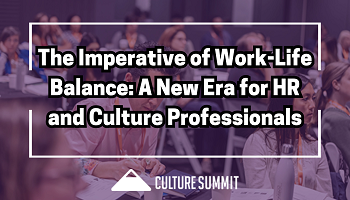
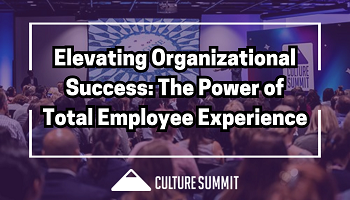
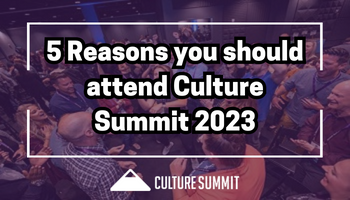
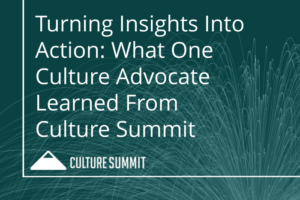
 Photo Credit: Cathryn Lynne Photo
Photo Credit: Cathryn Lynne Photo





